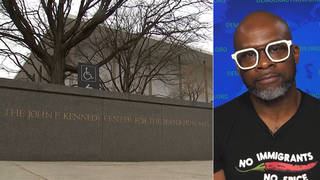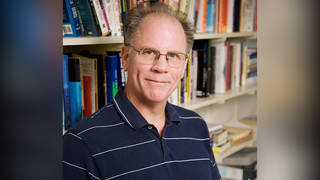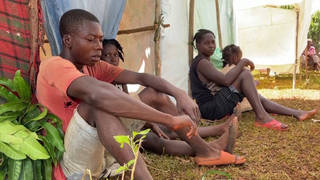
Haiti is struggling to recover six months after the earthquake — one of the worst natural disasters in history. Up to 300,000 were killed, and more than 1.5 million were made homeless. We go inside the Camp de Mars tent camp across from the crushed national palace in Port-au-Prince to let the Haitians living there tell their stories. [includes rush transcript]
Transcript
SHARIF ABDEL KOUDDOUS: We’re just back from Haiti, a country struggling to recover six months after the earthquake, one of the worst natural disasters in history. Up to 300,000 were killed and more than 1.5 million were made homeless.
We were in Haiti days after the earthquake struck on January 12th. We saw the devastation, the collapsed buildings, the dead bodies, the suffering. What we saw this time, half a year later, is that little has changed. Port-au-Prince looks like a war zone. Mountains of rubble line the streets as before. Even debris from the national palace has not been cleared. There is little food, clean water or sanitation.
AMY GOODMAN: On Monday, we brought you the voices of Haitians living in one of the government’s primary relocations camps outside Port-au-Prince in Corail, situated on a forbidding stretch of desert. Well, today we go inside one of the tent camps in Port-au-Prince to let the Haitians living there tell their stories.
AMY GOODMAN: We’re standing in the Champ de Mars. This is the big plaza in front of the palace that, since the earthquake six months ago, has crumbled. This has expanded to camp of, oh, thousands of people. There are more than 1,300 displaced-persons camps throughout Haiti. This one is one of the largest. We’re just going to walk inside right now.
OK, let’s walk.
STANLEY ALPHONSE: Good morning. My name is Stanley Alphonse.
[translated] After the earthquake, we all came and set up here. We always pose the question: What can the government do with us? We never got a very normal or concrete response. We always are doing demonstrations, and we put the word out in the press, but we never find any response. We still need aid. We still need them to send us to a place that’s better than this, because living here on Petion Place is not something that’s logical. This is a place where tourists are supposed to come; it’s supposed to be a place where people come to play.
AMY GOODMAN: In the backdrop, you have the crumbling palace. You’ve got the leaders of Haiti from the past, from independence, like Dessalines, the statues in the park. And then you’ve got thousands of people who have been waiting for something more permanent than these temporary tarps and tents that they’ve been living in now for six months.
Simonis Ricardo, you’re a journalist, and you’re here in the camp. Describe the camp to us.
SIMONIS RICARDO: [translated] We see that the people live here with very meager means. A lot of countries and partners have offered a lot of aid to the country. Even after the schools opened, a lot of kids still could not return to school because they lost their mothers in the earthquake. Even though we know there’s a state of emergency, but we ask what they’re going to do to evacuate people from the camps. We have a lot of problems here. For example, the water here is not treated; it is not drinkable, usable. We have people who have vitamin deficiencies here in the camp. And I could have you speak with one of the mothers responsible for these children who have vitamin deficiencies.
AMY GOODMAN: We’ve come to the home of Sinfordorio Fedelin [phon.]. She’s with her child. They’re both very hungry.
How long have you lived in the camp?
CHAMP DE MARS RESIDENT: [translated] Since after January 12th.
AMY GOODMAN: When was your baby born?
CHAMP DE MARS RESIDENT: [translated] He was born on the 20th of May, 2009.
AMY GOODMAN: Does he have enough to eat?
CHAMP DE MARS RESIDENT: [translated] No.
AMY GOODMAN: What do you have to feed him?
CHAMP DE MARS RESIDENT: [translated] I don’t have anything to give him.
AMY GOODMAN: Are you eating, yourself?
CHAMP DE MARS RESIDENT: [translated] Yeah, if I find something, I eat it, but I often don’t find.
AMY GOODMAN: Do you know when you can leave the camp?
CHAMP DE MARS RESIDENT: [translated] I don’t know when I’m getting out of here. I have nowhere to go.
AMY GOODMAN: Do people come by to bring food to you?
CHAMP DE MARS RESIDENT: [translated] No.
AMY GOODMAN: Are you hungry?
CHAMP DE MARS RESIDENT: [translated] Yes, I am hungry.
AMY GOODMAN: Do you get clean water?
CHAMP DE MARS RESIDENT: [translated] No, it’s not good. What we have, we use it, but it’s not good.
AMY GOODMAN: Does it make you sick?
CHAMP DE MARS RESIDENT: [translated] Yes.
AMY GOODMAN: Is there anything else you’d like to tell us?
CHAMP DE MARS RESIDENT: [translated] Get me out of here, because I have nowhere else to go. This is where I’m staying, but I don’t have anything here.
AMY GOODMAN: The Champ de Mars camp has more than 10,000 — maybe 20,000 — people still packed in, in filthy, unsanitary, painful conditions. We saw it after January 12th when we came just after the earthquake, and six months later we see the same thing. The camp lies in the shadow of another ruin, and that is the palace, built almost a hundred years ago. It too stands in ruins. Right next to this — on one of the pillars right here outside the palace is some graffiti. It says, “Viv Retou Titid” — “Long live the return of Titid,” the affectionate name for Aristide. It’s interesting, because as we were leaving the camp, a young man came up to us, and he said he was too traumatized to speak, but he felt things would be different if President Aristide were to return. Well, who knows if that is the case, but what we do know is Haiti remains very much the same as we found it six months ago, when the earthquake struck. I’m Amy Goodman, in Port-au-Prince, Haiti.












Media Options